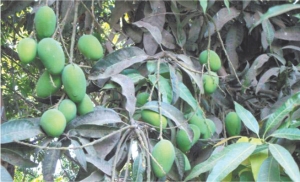| Home - Back Issues - The Team - Contact Us |
 |
| Volume 11 |Issue 27| July 07, 2012 | |
|
|
Impressions
Shah Husain Imam
Granted, this is an overstatement for most consumers who have to buy chemically ripened mangoes. The contamination seeps in through dipping the mangoes, picked when green, in carbide-mixed water and whisking these off to wholesale and then retail outlets. The other method is spraying the fruit on the trees which is said to be less risky. The use of artificial preservatives to the peril of public health can be largely avoided if we have scientific storage facilities from the time the mangoes mature through their ripening to eventual marketing. The luckiest of the mango-lovers are those who can procure their weekly provision from the mango groves direct. The king of fruits it is (wonder why Hilsha, its gender regardless, should be called the king of fish)! The king stands for the best, why not the queen? No questions asked, mangoes are indeed kingly if you go by mango-centric anecdotes spun around high-profile persons. One of them goes like this: AK Fazlul Haque, a most revered national leader, was then the governor of East Pakistan; he glimpsed a basketful of mangoes passing by the doorway to his office room. He at once called up the man carrying the basket, took a peek into it and started picking up mangoes, skinning them in the corner and consuming them whole. He ate with such relish as to be unmindful of the dripping juice drenching part of the attire on his torso. Such proverbial was Sher-e-Bangla's delight of delicacies. An International Herald Tribune story titled The fruit of envy, love and rivalry by Jim Yardley (May 30, 2012) recalls how Alphonso was served when the first Indian prime minister Jawaharlal Nehru attended a state dinner in Washington with the then President John F. Kennedy. It was one-off import of the delicacy as for decades Indian mangoes were banned and then allowed limited import because of US requirements on irradiation, among other issues. Incidentally, the Americans insisted that the seeds of the Alphonsos, the fruit served to Nehru, were later burned.
What the US agriculture department had tabooed, somehow nature, knowing no boundaries, defied. The US scientists were startled to find Bluefin Tuna carrying radioactive contamination from the Fukushima nuclear disaster lapping with to the shores of Los Angeles travelling 9,700 kilometres of the Pacific ocean (though the radiation is within safe limit). There is mango jingoism between north and south of India. Each region competing with the other in terms of variety, flavour, sweetness, non-fibrous succulence of the mangoes. India is known to annually produce about 15 million tonnes of mangoes, some 40 percent of the world production. Between 40 and 60 varieties are sold commercially.
India and Pakistan producing impressively colourful, tasty and honey-sweet mangoes are substantial exporters of the commodity to different parts of the world. The fruit is in high demand among their diasporas. Bangladesh produces more than 8,00,000 metric tonnes with almost one-fourth concentrated in one district i.e. Chapainaw-abganj. Most of the commodity is consumed domestically; Bangladeshi mangoes are not very much into export, at least not anywhere near the level comparable with Pakistan and India. Mango processing industry with both green and ripe varieties as raw material has a great future. This potential needs to be tapped in on. Along this, backyard farming of mangoes is picking up; some success stories have been run by newspapers lately. Marketing of mangoes locally has received an impetus through fruit fairs organised in-season by various private parties and clubs. This together with other mango promotion steps could help transform the business of mango production and distribution from an informal into a formal sector. The writer is Associate Editor, The Daily Star.
|
||||
Copyright
(R) thedailystar.net 2012 |
 The Mango Party is almost Over!
The Mango Party is almost Over!
